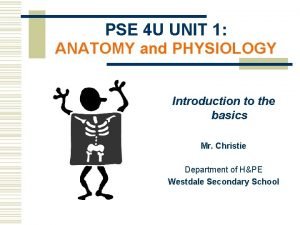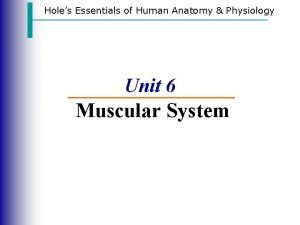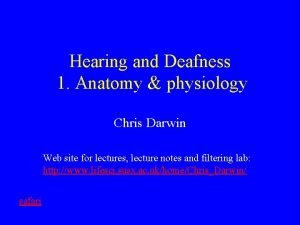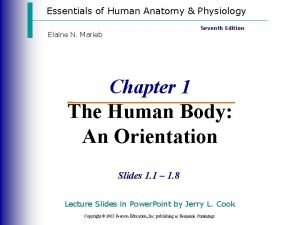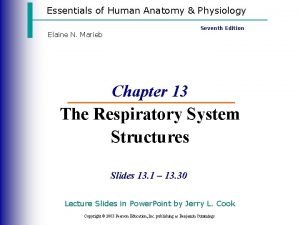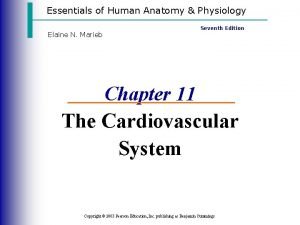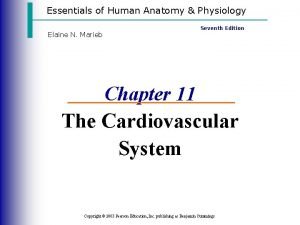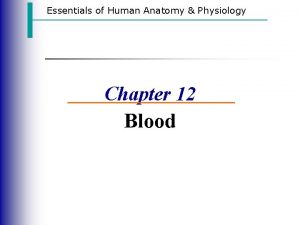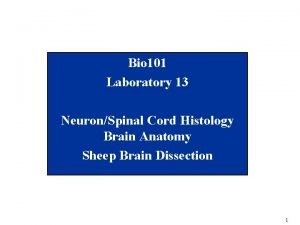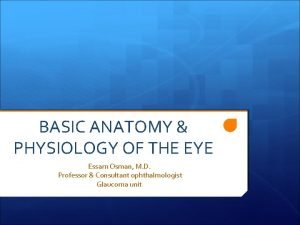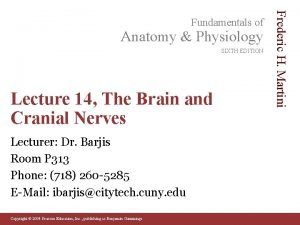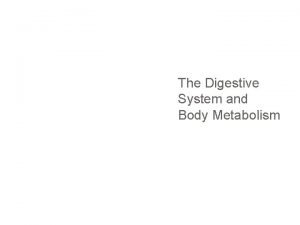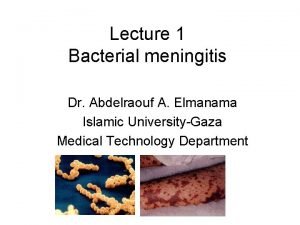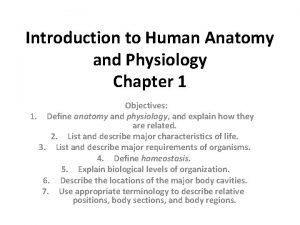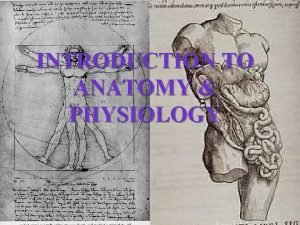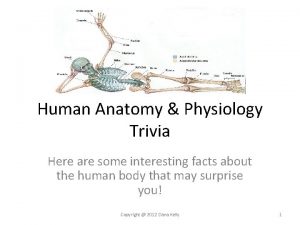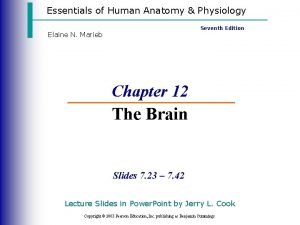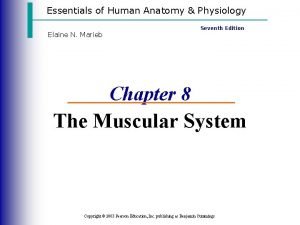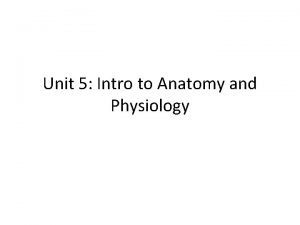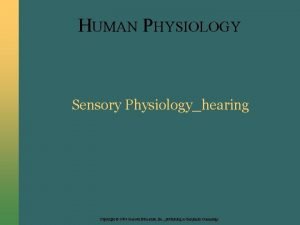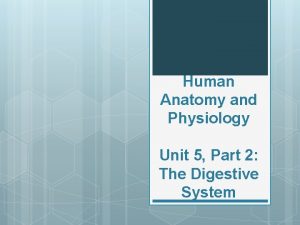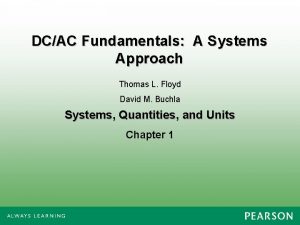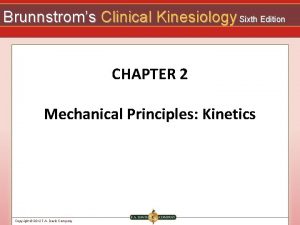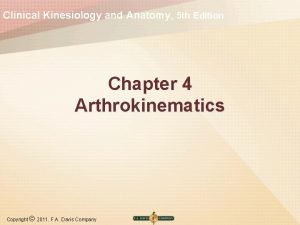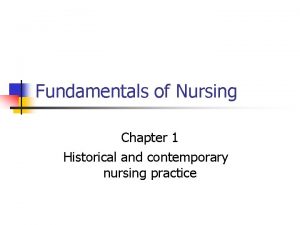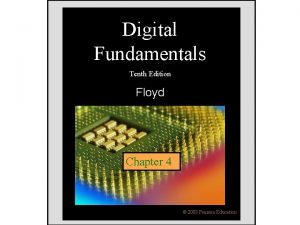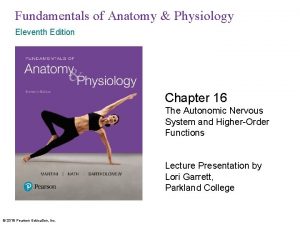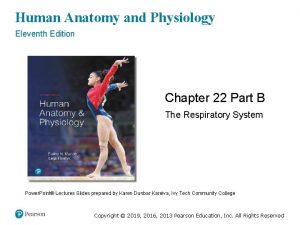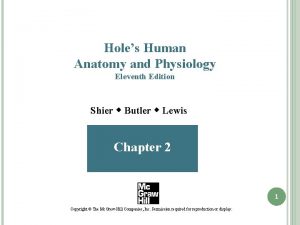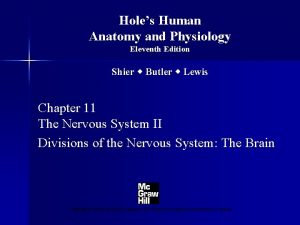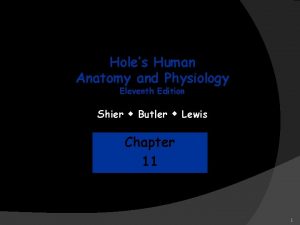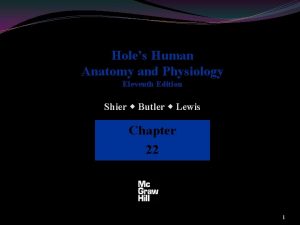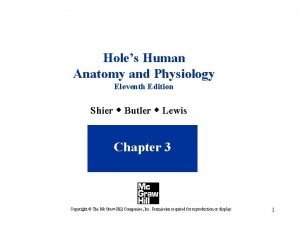Fundamentals of Anatomy Physiology Eleventh Edition Chapter 22


































































































































- Slides: 130

Fundamentals of Anatomy & Physiology Eleventh Edition Chapter 22 The Lymphatic System and Immunity Lecture Presentation by Deborah A. Hutchinson Seattle University © 2018 Pearson Education, Inc.

Introduction: Lymphatic System and Immunity § Pathogens – Microscopic organisms that cause disease • Viruses • Bacteria • Fungi • Parasites – Each attacks in a specific way 2 © 2018 Pearson Education, Inc.

Introduction: Lymphatic System and Immunity § Lymphatic system (lymphoid system) – Protects us against disease – Lymphatic system cells respond to • Environmental pathogens • Toxins • Abnormal body cells, such as cancers – Lymphocytes • Part of the immune response • Identify, attack, and develop immunity to specific pathogens 3 © 2018 Pearson Education, Inc.

Introduction: Lymphatic System and Immunity § Immune system – Immunity • The ability to resist infection and disease – All body cells and tissues are involved in production of immunity • Not just lymphatic system 4 © 2018 Pearson Education, Inc.

22 -1 Components of Lymphatic System § Components of lymphatic system – Lymph • A fluid similar to plasma but without plasma proteins – Lymphatic vessels • Carry lymph from peripheral tissues to veins – Lymphoid tissues and lymphoid organs • Scattered throughout body – Lymphoid cells • Lymphocytes, phagocytes, and other cells 5 © 2018 Pearson Education, Inc.

Figure 22– 1 The Components of the Lymphatic System (Part 1 of 2). Lymph Nodes and Lymphatic Vessels Cervical lymph nodes Thoracic duct Right lymphatic duct Axillary lymph nodes Lymphatics of mammary gland Other Lymphoid Tissues and Organs Tonsil Thymus Cisterna chyli Lymphatics of upper limb Lumbar lymph nodes Spleen Mucosa-associated lymphatic tissue (MALT) in digestive, respiratory, urinary, and reproductive tracts 6

Figure 22– 1 The Components of the Lymphatic System (Part 2 of 2). Lymph Nodes and Lymphatic Vessels Pelvic lymph nodes Other Lymphoid Tissues and Organs Appendix Red bone marrow Inguinal lymph nodes Lymphatics of lower limb Lymphocyte 7

22 -1 Components of Lymphatic System § Lymphocytes are produced in – Primary lymphoid tissues and organs – Red bone marrow and thymus § Lymphocytes are activated in – Secondary lymphoid tissues and organs – Tonsils, MALT, lymph nodes, and spleen 8 © 2018 Pearson Education, Inc.

22 -1 Components of Lymphatic System § Functions of lymphatic system – Produce, maintain, and distribute lymphocytes and other lymphoid cells – Return excess fluid to bloodstream – Maintain normal blood volume – Transport hormones, nutrients, and wastes 9 © 2018 Pearson Education, Inc.

22 -1 Components of Lymphatic System § Lymphatic vessels (lymphatics) – Carry lymph—interstitial fluid that has entered lymphatic vessels • From peripheral tissues to venous system 10 © 2018 Pearson Education, Inc.

22 -1 Components of Lymphatic System § Lymphatic capillaries – Differ from blood capillaries in several ways • Closed at one end rather than forming a tube • Have larger luminal diameters • Have thinner walls • Have flat or irregular outline in sectional view – Endothelial cells loosely bound together – Overlap of endothelial cells acts as one-way valve • Allows fluids, solutes, viruses, and bacteria to enter • Prevents their return to intercellular spaces 11 © 2018 Pearson Education, Inc.

Figure 22– 2 a Lymphatic Capillaries. Smooth muscle Arteriole Venule Endothelial cells Lymphatic capillary Interstitial fluid Lymph flow Blood capillaries Areolar tissue a The interwoven network formed by blood capillaries and lymphatic capillaries. Arrows indicate the movement of fluid out of blood capillaries and the net flow of interstitial fluid and lymph. 12

22 -1 Components of Lymphatic System § Lymph flows – From lymphatic capillaries to larger lymphatic vessels containing one-way valves § Lacteals – Special lymphatic capillaries in small intestine – Transport lipids from digestive tract 13 © 2018 Pearson Education, Inc.

22 -1 Components of Lymphatic System § Lymphatic vessels – Superficial lymphatics – Deep lymphatics • Larger vessels that accompany arteries and veins – Located in skin, mucous membranes, and serous membranes lining body cavities – Join to form large lymphatic trunks that empty into two major collecting vessels • Thoracic duct • Right lymphatic duct 14 © 2018 Pearson Education, Inc.

22 -1 Components of Lymphatic System § Thoracic duct – Base expands to form cisterna chyli, which receives lymph from • Right and left lumbar trunks • Intestinal trunk – Inferior segment collects lymph from • Left bronchomediastinal trunk • Left subclavian trunk • Left jugular trunk – Empties into left subclavian vein 15 © 2018 Pearson Education, Inc.

22 -1 Components of Lymphatic System § Right lymphatic duct – Collects lymph from • Right jugular trunk • Right subclavian trunk • Right bronchomediastinal trunk – Empties into right subclavian vein 16 © 2018 Pearson Education, Inc.

Figure 22– 4 a The Relationship between the Lymphatic Ducts and the Venous System. Drainage of right lymphatic duct Drainage of thoracic duct a The thoracic duct carries lymph from tissues inferior to the diaphragm and from the left side of the upper body. The smaller right lymphatic duct carries lymph from the rest of the body. 17

Figure 22– 4 b The Relationship between the Lymphatic Ducts and the Venous System (Part 1 of 2). Brachiocephalic veins Right internal jugular vein Right jugular trunk Right lymphatic duct Right subclavian trunk Right subclavian vein Right bronchomediastinal trunk Superior vena cava (cut) Azygos vein Rib (cut) Inferior vena cava (cut) Right lumbar trunk b The thoracic duct empties into the left subclavian vein. The right lymphatic duct empties into the right subclavian vein. 18

Figure 22– 4 b The Relationship between the Lymphatic Ducts and the Venous System (Part 2 of 2). Brachiocephalic veins Left internal jugular vein Left jugular trunk Thoracic duct Left subclavian trunk Left bronchomediastinal trunk Left subclavian vein First rib (cut) Highest intercostal vein Thoracic duct Thoracic lymph nodes Hemi-azygos vein Parietal pleura (cut) Diaphragm Cisterna chyli Intestinal trunk Left lumbar trunk b The thoracic duct empties into the left subclavian vein. The right lymphatic duct empties into the right subclavian vein. 19

22 -1 Components of Lymphatic System § Lymphedema – Blockage of lymph drainage from a limb – Causes severe swelling – Interferes with immune system function § Lymphoid cells – Immune system cells and supportive cells in lymphoid tissues – Lymphocytes • Make up 20– 40 percent of circulating leukocytes • Most are stored, not circulating 20 © 2018 Pearson Education, Inc.

22 -1 Components of Lymphatic System § Types of lymphocytes – T cells • Thymus-dependent – B cells • Bone marrow–derived – NK cells • Natural killer cells 21 © 2018 Pearson Education, Inc.

22 -1 Components of Lymphatic System § Lymphoid tissues – Connective tissues dominated by lymphocytes § Lymphoid nodules (lymphatic nodules) – Areolar tissue with densely packed lymphocytes – Germinal center contains dividing lymphocytes – Distributed in • Lymph nodes • Spleen • Respiratory tract (tonsils) • Along digestive, urinary, and reproductive tracts 22 © 2018 Pearson Education, Inc.

Figure 22– 5 b Lymphoid Nodules (Part 1 of 2). Intestinal lumen Mucous membrane of intestinal wall Aggregated lymphoid nodule in intestinal mucosa Underlying connective tissue Germinal center b Aggregated lymphoid nodules in the intestine 23

22 -1 Components of Lymphatic System § Five tonsils in wall of pharynx – Pharyngeal tonsil (adenoid) – Left and right palatine tonsils – Two lingual tonsils § Tonsillitis – Inflammation of tonsils, especially palatine tonsils 24 © 2018 Pearson Education, Inc.

Figure 22– 5 a Lymphoid Nodules (Part 1 of 2). 25

22 -1 Components of Lymphatic System § Mucosa-associated lymphoid tissue (MALT) – Lymphoid tissues associated with digestive system – Aggregated lymphoid nodules • Clustered deep to intestinal epithelial lining § Appendix (vermiform appendix) – Contains a mass of fused lymphoid nodules 26 © 2018 Pearson Education, Inc.

22 -1 Components of Lymphatic System § Lymphoid organs – Include • Lymph nodes • Thymus • Spleen – Separated from surrounding tissues by a fibrous connective tissue capsule 27 © 2018 Pearson Education, Inc.

22 -1 Components of Lymphatic System § Lymph nodes – Trabeculae • Bundles of collagen fibers • Extend from capsule into interior of lymph node – Hilum • Shallow indentation where blood vessels and nerves reach lymph node 28 © 2018 Pearson Education, Inc.

22 -1 Components of Lymphatic System § Lymph nodes – Afferent lymphatics • Carry lymph from peripheral tissues to lymph node – Efferent lymphatics • Leave lymph node at hilum • Carry lymph to venous circulation 29 © 2018 Pearson Education, Inc.

Figure 22– 6 The Structure of a Lymph Node (Part 1 of 2). Lymphatic vessel Lymph nodes Efferent vessel Lymph node artery and vein Hilum Trabeculae Lymph nodes Medulla (B cells and macrophages) Medullary sinus Cortex (B cells) Subcapsular space Paracortex (T cells) Dividing Capsule Medullary cord Afferent vessel 30

22 -1 Components of Lymphatic System § Lymph flow through nodes – From subcapsular space • Contains macrophages and dendritic cells – Through outer cortex • Contains B cells within germinal centers – Through paracortex (dominated by T cells) – Through the core (medulla) • Organized into medullary cords • Contains B cells and macrophages – Finally, into efferent lymphatics at hilum 31 © 2018 Pearson Education, Inc.

22 -1 Components of Lymphatic System § Lymph node function – Purify lymph before return to venous circulation • Remove 99 percent of antigens – Antigens released due to infection • Enter lymph and stimulate macrophages and lymphocytes in lymph nodes • Are also carried by dendritic cells to lymph nodes § Lymphoid tissues and lymph nodes – Monitor peripheral infections – Respond before infections reach vital organs 32 © 2018 Pearson Education, Inc.

22 -1 Components of Lymphatic System § Lymph nodes of gut, trachea, lungs, thoracic duct – Protect against pathogens in digestive and respiratory systems § Largest lymph nodes – In groin, axillae, and base of neck – Swell in response to infection § Lymphadenopathy – Chronic or excessive enlargement of lymph nodes – May indicate infections or cancer 33 © 2018 Pearson Education, Inc.

22 -1 Components of Lymphatic System § Thymus – Located in mediastinum – Atrophies after puberty • Diminishing effectiveness of immune system – Divided into two thymic lobes – Septa divide lobes into smaller lobules 34 © 2018 Pearson Education, Inc.

22 -1 Components of Lymphatic System § Thymic lobule – Dense outer cortex – Pale central medulla § Lymphocytes – Divide in cortex – Migrate into medulla – Mature T cells leave thymus by medullary blood vessels 35 © 2018 Pearson Education, Inc.

22 -1 Components of Lymphatic System § Epithelial reticular cells – Surround lymphocytes in cortex – Form layered structures in medulla known as thymic (Hassall’s) corpuscles – Maintain blood thymus barrier in cortex • Absent in medulla § Thymic hormones – Thymosin—an extract from thymus containing several hormones • Promotes development and maturation of T cells 36 © 2018 Pearson Education, Inc.

Figure 22– 7 a The Thymus. Thyroid gland Trachea Thymus Left lobe Right lung Left lung Heart Diaphragm a The appearance and position of the thymus in relation to other organs in the chest. 37

22 -1 Components of Lymphatic System § Functions of the spleen 1. Removal of abnormal blood cells and other blood components by phagocytosis 2. Storage of iron recycled from red blood cells 3. Initiation of immune responses by B cells and T cells • In response to antigens in circulating blood 38 © 2018 Pearson Education, Inc.

22 -1 Components of Lymphatic System § Anatomy of the spleen – Attached to stomach by gastrosplenic ligament – Contacts diaphragm and left kidney – Splenic veins, arteries, and lymphatic vessels • Communicate with spleen at hilum § Histology of the spleen – Cellular components within capsule make up pulp • Red pulp contains many red blood cells • White pulp resembles lymphoid nodules 39 © 2018 Pearson Education, Inc.

22 -1 Components of Lymphatic System § Trabecular arteries – Branch and radiate toward capsule – Finer branches surrounded by white pulp – Capillaries discharge red blood cells into red pulp § Red pulp – Contains elements of circulating blood • Plus fixed and free macrophages 40 © 2018 Pearson Education, Inc.

22 -1 Components of Lymphatic System § Splenic circulation – Blood passes through network of reticular fibers – Then enters large sinusoids lined by macrophages • Which empty into trabecular veins 41 © 2018 Pearson Education, Inc.

22 -1 Components of Lymphatic System § Spleen function – Phagocytes and other lymphocytes in spleen • Identify and attack damaged and infected cells in circulating blood § Splenectomy – Removal of a severely ruptured spleen 42 © 2018 Pearson Education, Inc.

22 -2 Innate and Adaptive Immunity § Immunity – Ability to resist and defend against infectious organisms and other damaging substances – Resistance • Ability of body to maintain immunity § Immune response – Body’s reaction to infectious agents and other abnormal substances 43 © 2018 Pearson Education, Inc.

22 -2 Innate and Adaptive Immunity § Two types of immunity – Innate (nonspecific) immunity • Always works the same way • Against any type of invading agent – Adaptive (specific) immunity • Protects against specific pathogens • Depends on activities of lymphocytes • Develops after exposure to environmental hazards 44 © 2018 Pearson Education, Inc.

22 -2 Innate and Adaptive Immunity § Lymphocytes – B cells, T cells, and NK cells § Lymphocyte distribution – Tissues maintain different T cell and B cell populations – Lymphocytes wander through tissues • Enter blood vessels or lymphatics for transport • Can survive many years 45 © 2018 Pearson Education, Inc.

22 -2 Innate and Adaptive Immunity § Lymphocyte production – Also called lymphocytopoiesis, involves • Bone marrow • Thymus • Peripheral lymphoid tissues – Hemocytoblasts in bone marrow • Divide into two types of lymphoid stem cells 46 © 2018 Pearson Education, Inc.

22 -2 Innate and Adaptive Immunity § Lymphoid stem cells – Group 1 • Remain in bone marrow and develop with help of stromal cells • Produce B cells and NK cells • B cells differentiate with exposure to interleukin-7 – Group 2 • Migrate to thymus • Develop in environment isolated from blood • T cells differentiate with exposure to hormones 47 © 2018 Pearson Education, Inc.

Figure 22– 9 The Origin and Distribution of Lymphocytes (Part 1 of 3). Red Bone Marrow One group of stem cells remains in the red bone marrow, producing daughter cells that mature into NK cells and B cells. Hemocytoblasts Interleukin-7 Lymphoid stem cells NK cells Lymphoid stem cells B cells 48

Figure 22– 9 The Origin and Distribution of Lymphocytes (Part 2 of 3). Thymus The second group of stem cells migrates to the thymus, where subsequent divisions produce daughter cells that mature into T cells. Migrate to thymus Thymic hormones Lymphoid stem cells Production, selection, and differentiation of T cells Mature T cells 49

22 -2 Innate and Adaptive Immunity § T cells and B cells – Migrate throughout body • To defend peripheral tissues – Retain their ability to divide • Essential to immune system function 50 © 2018 Pearson Education, Inc.

22 -3 Innate Defenses § Physical barriers – Outer layer of skin – Hair – Epithelial layers of internal passageways – Secretions that flush away materials • Sweat, mucus, and urine – Secretions that kill or inhibit microorganisms • Containing enzymes, antibodies, or stomach acid 51 © 2018 Pearson Education, Inc.

22 -3 Innate Defenses § Phagocytes – Attack and remove dangerous microorganisms – Microphages • Neutrophils and eosinophils • Enter peripheral tissues to fight infections – Macrophages • Large phagocytic cells derived from monocytes • Distributed throughout body • Make up monocyte–macrophage system (reticuloendothelial system) 52 © 2018 Pearson Education, Inc.

22 -3 Innate Defenses § Activated macrophages – Respond to pathogens in several ways • Engulf pathogen and destroy it with lysosomal enzymes • Bind to pathogen so other cells can destroy it • Destroy pathogen by releasing toxic chemicals into interstitial fluid 53 © 2018 Pearson Education, Inc.

22 -3 Innate Defenses § Types of macrophages – Fixed macrophages (histiocytes) • Stay in specific tissues and organs (e. g. , dermis and bone marrow) • Microglia found in central nervous system • Stellate macrophages found in liver sinusoids – Free macrophages (wandering macrophages) • Travel throughout body • Alveolar macrophages (phagocytic dust cells) 54 © 2018 Pearson Education, Inc.

22 -3 Innate Defenses § Free macrophages and microphages – Move through capillary walls (emigration) – Are attracted or repelled by chemicals in surrounding fluids (chemotaxis) – Phagocytosis begins • When phagocyte attaches to target (adhesion) • And surrounds it with a vesicle 55 © 2018 Pearson Education, Inc.

22 -3 Innate Defenses § Immune surveillance – Carried out by natural killer (NK) cells – Activated NK cells 1. Identify and adhere to abnormal cells 2. Golgi apparatus produces vesicles containing perforins 3. Vesicles release perforins by exocytosis 4. Perforins form pores in abnormal cell’s plasma membrane, causing lysis 56 © 2018 Pearson Education, Inc.

22 -3 Innate Defenses § Immune surveillance – Tumor-specific antigens • On plasma membranes of cancer cells • Identified as abnormal by NK cells • Some cancer cells avoid detection (immunological escape) – Cells infected with viruses • Present abnormal proteins on plasma membranes • Allows NK cells to identify and destroy them 57 © 2018 Pearson Education, Inc.

22 -3 Innate Defenses § Interferons (IFNs) – Small proteins released by activated lymphocytes and macrophages – Trigger production of antiviral proteins – Antiviral proteins do not kill viruses • Block viral replication in the cell – IFNs are one type of cytokine – Cytokines • Chemical messengers released by tissue cells • Important to immune response 58 © 2018 Pearson Education, Inc.

22 -3 Innate Defenses § Complement system – More than 30 special complement proteins in plasma – Assists antibodies in destruction of pathogens – Complement proteins work together in cascades – Three routes of activation of complement • Classical pathway • Lectin pathway • Alternative pathway 59 © 2018 Pearson Education, Inc.

22 -3 Innate Defenses § Classical pathway of complement activation – Most rapid and effective mode of activation – Begins with binding of complement protein C 1 • To two antibodies attached to antigen – Bound protein acts as an enzyme • Catalyzes chain reaction 60 © 2018 Pearson Education, Inc.

22 -3 Innate Defenses § Lectin pathway of complement activation – Mannose-binding lectin (MBL) binds to carbohydrates on pathogen surfaces § Alternative pathway of complement activation – Begins when several complement proteins interact • Properdin (factor P) • Factor B • Factor D 61 © 2018 Pearson Education, Inc.

22 -3 Innate Defenses § Inflammation – Localized tissue response to injury – Triggered by any stimulus that kills cells or injures tissue – Cardinal signs and symptoms of inflammation • Redness • Swelling • Heat • Pain 62 © 2018 Pearson Education, Inc.

22 -3 Innate Defenses § Effects of inflammation – Temporarily repair injury • Prevent additional pathogens from entering wound – Slow spread of pathogens to surrounding areas – Mobilize local, regional, and systemic defenses • To overcome pathogens and facilitate permanent repairs (regeneration) 63 © 2018 Pearson Education, Inc.

22 -3 Innate Defenses § Products of inflammation – Necrosis • Local tissue destruction in area of injury – Pus • Mixture of debris, fluid, dead and dying cells, and necrotic tissue – Abscess • Accumulation of pus in an enclosed space 64 © 2018 Pearson Education, Inc.

22 -3 Innate Defenses § Fever – A body temperature greater than 37. 2ºC (99ºF) • Increases metabolic rate • Accelerates defenses • Inhibits some viruses and bacteria 65 © 2018 Pearson Education, Inc.

22 -3 Innate Defenses § Pyrogens – Fever-inducing agents – Produced by bacteria, molds, viruses, and yeasts – Cause hypothalamus to raise body temperature – Endogenous pyrogens • Interleukin-1, interferons, and tumor necrosis factor 66 © 2018 Pearson Education, Inc.

22 -4 Adaptive Defenses § Adaptive (specific) defenses – Result from coordinated activities of T cells and B cells 67 © 2018 Pearson Education, Inc.

22 -4 Adaptive Defenses § Primary types of T cells – Cytotoxic T cells • Attack antigens physically and chemically – Helper T cells • Stimulate responses of T cells and B cells – Regulatory T cells • Moderate immune response – Memory T cells • Respond to antigens previously encountered 68 © 2018 Pearson Education, Inc.

22 -4 Adaptive Defenses § Types of regulatory T cells – Inflammatory T cells – Suppressor/inducer T cells § B cells – Make up 10– 15 percent of circulating lymphocytes – Differentiate into plasma cells • Produce and secrete antibodies § Natural killer (NK) cells – Make up 5– 10 percent of circulating lymphocytes 69 © 2018 Pearson Education, Inc.

Figure 22– 15 Classes of Lymphocytes subdivided into T Cells Approximately 80% of circulating lymphocytes are classified as T cells. Cytotoxic T Cells Cytotoxic T cells attack foreign cells or body cells infected by viruses. differentiate into Helper T Cells Helper T cells stimulate the activation and function of both T cells and B cells. Regulatory T Cells Regulatory T cells moderate both T cells and B cells. Memory T Cells Memory T cells are a subset of T cells that respond to a previously encountered antigen. B Cells NK Cells B cells make up 10– 15% of circulating lymphocytes. NK cells make up the remaining 5– 10% of circulating lymphocytes. Plasma Cells When stimulated, B cells can differentiate into plasma cells, which produce and secrete antibodies. 70

22 -4 Adaptive Defenses § Cell-mediated immunity (cellular immunity) – Provided by cytotoxic T cells – Defends against abnormal cells and pathogens inside cells § Antibody-mediated immunity – Provided by B cells – Defends against antigens and pathogens in body fluids 71 © 2018 Pearson Education, Inc.

Figure 22– 16 An Overview of Adaptive Immunity. Cell-Mediated Immunity Adaptive Immunity Antigen presentation triggers an immune response by specific defenses. Phagocytes activated T cells activated Direct Physical and Chemical Attack Activated T cells find the pathogens and attack them through phagocytosis or the release of chemical toxins. Communication and feedback Antibody-Mediated Immunity Attack by Circulating Antibodies Destruction of antigens Activated B cells give rise to cells that produce antibodies. 72

22 -4 Adaptive Defenses § Adaptive immunity – Antigens • Chemical targets that stimulate immune response – When a lymphocyte contacts an appropriate antigen • It becomes activated – An activated lymphocyte divides to produce a clone – Clonal selection • Process of an antigen “selecting” lymphocytes for cloning 73 © 2018 Pearson Education, Inc.

22 -4 Adaptive Defenses § Forms of immunity – Innate immunity • Present at birth – Adaptive immunity • Acquired after birth – Active immunity • Develops after exposure to antigen – Passive immunity • Produced by transferring antibodies from another source 74 © 2018 Pearson Education, Inc.

Figure 22– 17 Forms of Immunity Ability to resist infection and disease Innate (Nonspecific) Immunity Adaptive (Specific) Immunity Adaptive immunity is not present at birth. You acquire immunity to a specific antigen only when you have been exposed to that antigen or receive antibodies from another source. Genetically determined— no prior exposure or antibody production involved Active Immunity Passive Immunity Develops in response to antigen exposure Produced by transfer of antibodies from another source Naturally Acquired Active Immunity Artificially Acquired Active Immunity Develops after exposure to antigens in environment Develops after administration of an antigen to prevent disease Naturally Acquired Passive Immunity Artificially Acquired Passive Immunity Conferred by transfer of maternal antibodies across placenta or in breast milk Conferred by administration of antibodies to combat infection 75

22 -4 Adaptive Defenses § Active immunity – Naturally acquired active immunity • Through environmental exposure to pathogens – Artificially acquired active immunity • Through vaccines § Passive immunity – Naturally acquired passive immunity • Antibodies acquired from the mother – Artificially acquired passive immunity • By an injection of antibodies 76 © 2018 Pearson Education, Inc.

22 -4 Adaptive Defenses § Four properties of adaptive immunity – Specificity • Each T or B cell responds only to a specific antigen and ignores all others – Versatility • The body produces many types of lymphocytes – Each fights a different type of antigen – An activated lymphocyte clones itself to fight a specific antigen 77 © 2018 Pearson Education, Inc.

22 -4 Adaptive Defenses § Four properties of immunity – Memory • Some inactive lymphocytes (memory cells) – Stay in circulation – Provide immunity against new exposure – Tolerance • Immune system ignores “normal” antigens (selfantigens) 78 © 2018 Pearson Education, Inc.

22 -5 T Cells and Immunity § T cells are activated by exposure to an antigen § Antigen presentation – T cells recognize only antigens that are “presented” by antigen-presenting cells – MHC proteins • Membrane glycoproteins that bind antigens • Genetically coded by major histocompatibility complex (MHC) in chromosome 6 79 © 2018 Pearson Education, Inc.

22 -5 T Cells and Immunity § Two classes of MHC proteins – Class I MHC proteins • Found in membranes of all nucleated cells • Pick up small peptides in cell and carry them to the surface • T cells ignore normal peptides • Abnormal peptides or viral proteins activate T cells to destroy cell 80 © 2018 Pearson Education, Inc.

22 -5 T Cells and Immunity § Class II MHC proteins – Found in membranes of lymphocytes and antigenpresenting cells (APCs) such as dendritic cells – Antigenic fragments • From antigen processing of pathogens • Bind to class II proteins • Inserted into plasma membrane – APC then presents the protein-antigen complex to T cells 81 © 2018 Pearson Education, Inc.

Figure 22– 18 c Antigens and MHC Proteins. 1 Plasma membrane Phagocytic APCs engulf the extracellular pathogens. 5 4 2 Antigenic fragments are displayed by class II MHC proteins on the plasma membrane. Antigenic fragments are bound to class II MHC proteins. 3 Lysosomal action produces antigenic fragments. The endoplasmic reticulum produces class II MHC proteins. Lysosome Nucleus Endoplasmic reticulum c Antigen-presenting cell (APC). 82

22 -5 T Cells and Immunity § Antigen recognition – Inactive T cells have receptors • That bind to class I or class II MHC proteins • Also have binding sites for specific antigen – Binding occurs when antigen matches receptor on T cell 83 © 2018 Pearson Education, Inc.

22 -5 T Cells and Immunity § To destroy target cell, a cytotoxic T cell may – Release perforins to destroy target cell’s plasma membrane, – Release cytokines and activate genes in target cell to trigger apoptosis, or – Secrete poisonous lymphotoxin 84 © 2018 Pearson Education, Inc.

22 -5 T Cells and Immunity § Memory TC cells – Produced with cytotoxic T cells – Stay in circulation – Immediately form cytotoxic T cells if same antigen appears again § Regulatory T cells – Secrete suppression factors – Inhibit responses of T and B cells – Act after initial immune response – Limit immune reaction to single stimulus 85 © 2018 Pearson Education, Inc.

Figure 22– 20 Antigen Recognition and Activation of Helper T Cells (Part 1 of 2). Antigen Recognition by CD 4 T Cell Foreign antigen Antigen-presenting cell (APC) Class II MHC Antigen APC Costimulation CD 4 protein Inactive CD 4 (TH) cell T cell receptor TH cell 86

Figure 22– 20 Antigen Recognition and Activation of Helper T Cells (Part 2 of 2). CD 4 T Cell Activation and Cell Division Memory TH cells (inactive) Active TH cells Cytokines Active helper T cells secrete cytokines that stimulate both cell-mediated antibody-mediated immunity. Cytokines 87

22 -5 T Cells and Immunity § Cytokines – Chemicals released by cells involved in immune response – Six major groups of cytokines • Interleukins • Interferons • Tumor necrosis factors • Phagocyte-activating chemicals • Colony-stimulating factors • Miscellaneous cytokines 88 © 2018 Pearson Education, Inc.

22 -5 T Cells and Immunity § Functions of interleukins 1. Increasing T cell sensitivity to antigens exposed on macrophage membranes 2. Stimulating B cell activity, plasma cell formation, and antibody production 3. Enhancing innate immunity by stimulating inflammation, mast cells, ACTH secretion, scar tissue formation, elevation of body temperature 4. Suppressing immune function and shortening immune response 89 © 2018 Pearson Education, Inc.

22 -5 T Cells and Immunity § Interleukins – IL-1 and IL 2, are important in stimulating and maintaining the immune response – When released by activated macrophages and lymphocytes, these cytokines stimulate activities of other immune cells and of the secreting cell – Result is a positive feedback loop that helps to recruit additional immune cells 90 © 2018 Pearson Education, Inc.

22 -5 T Cells and Immunity § Tumor necrosis factors (TNFs) – Slow growth of tumor and kill sensitive tumor cells – Stimulate granular leukocyte production, promote eosinophil activity, cause fever, and increase T cell sensitivity to interleukins – Activated macrophages secrete one type of TNF and carry the molecules in their membranes – Cytotoxic T cells produce a different type of TNF 91 © 2018 Pearson Education, Inc.

22 -5 T Cells and Immunity § Phagocyte-activating chemicals – Several cytokines coordinate immune defenses by adjusting activities of phagocytic cells – Some attract free macrophages and microphages and prevent premature departure from site of injury § Colony-stimulating factors (CSFs) – Produced by active T cells, cells of the monocyte– macrophage system, endothelial cells, and fibroblasts – Stimulate production of blood cells in red bone marrow and lymphocytes in lymphoid tissues and organs 92 © 2018 Pearson Education, Inc.

22 -5 T Cells and Immunity § Cytokines are often classified according to origins – Lymphokines are produced by lymphocytes – Monokines are secreted by active monocytes, macrophages, and other antigen-presenting cells – Lymphocytes and macrophages may secrete the same cytokines – Cells involved in adaptive immunity and tissue repair can also secrete cytokines 93 © 2018 Pearson Education, Inc.

22 -5 T Cells and Immunity § Functions of cytokines – Stimulate T cell divisions • Produce memory T cells • Accelerate cytotoxic T cell maturation – Attract and stimulate macrophages – Attract and stimulate activity of cytotoxic T cells – Promote activation of B cells 94 © 2018 Pearson Education, Inc.

22 -6 B Cells and Immunity § B cells – Responsible for antibody-mediated immunity – Attack antigens by producing specific antibodies – Millions of populations, each with different antibody molecules 95 © 2018 Pearson Education, Inc.

22 -6 B Cells and Immunity § B cell sensitization – Antigens in interstitial fluids bind to corresponding B cell receptors – B cell prepares for activation – During sensitization, antigens are • Taken into B cell • Processed • Reappear on surface, bound to class II MHC proteins 96 © 2018 Pearson Education, Inc.

22 -6 B Cells and Immunity § Activated B cell divides into – Plasma cells • Synthesize and secrete antibodies into interstitial fluid – Memory B cells • Like memory T cells, remain in reserve to respond to next infection 97 © 2018 Pearson Education, Inc.

Figure 22– 23 The Sensitization and Activation of B Cells (Part 3 of 3). 3 Division and Differentiation ANTIBODY PRODUCTION Stimulation by cytokines Plasma cells Activated B cells Memory B cells (inactive) 98

22 -6 B Cells and Immunity § Antibodies – Soluble proteins – Two pairs of polypeptide chains • One pair of heavy chains • One pair of light chains – Each chain contains • Constant segments • Variable segments 99 © 2018 Pearson Education, Inc.

Figure 22– 24 a Antibody Structure and Function. Antigen-binding site Variable segment Antigen-binding site Heavy chain Disulfide bond Light chain Complement binding site Constant segments of light and heavy chains Site of binding to macrophages a A diagrammatic view of the structure of an antibody. 100

Figure 22– 24 b Antibody Structure and Function. Light chain Antigenbinding site Heavy chain b A computer-generated image of a typical antibody. 101

22 -6 B Cells and Immunity § Variable segments of light and heavy chains – Determine specificity of antibody molecule § Free tips of two variable segments – Form antigen-binding sites of antibody molecule – Bind to antigenic determinant sites (epitopes) of antigen molecule § Antigen–antibody complex – An antibody bound to an antigen 102 © 2018 Pearson Education, Inc.

Figure 22– 24 c Antibody Structure and Function. Antigenic determinant sites Antigen Antibodies c Antibodies bind to portions of an antigen called antigenic determinant sites, or epitopes. 103

22 -6 B Cells and Immunity § Antigen–antibody complex – Complete antigen • Has at least two antigenic determinant sites • Binds to both antigen-binding sites of variable segments of antibody – Exposure to a complete antigen leads to • B cell sensitization • Immune response 104 © 2018 Pearson Education, Inc.

22 -6 B Cells and Immunity § Responses to antigen exposure – First exposure • Produces primary response – Next exposure • Triggers secondary response • More extensive and prolonged • Memory cells already primed 105 © 2018 Pearson Education, Inc.

22 -6 B Cells and Immunity § Primary response – Takes time to develop – Antigens activate B cells – Plasma cells differentiate – Antibody titer—level of antibodies in plasma • Slowly rises 106 © 2018 Pearson Education, Inc.

22 -6 B Cells and Immunity § Primary response – Peak response • Can take two weeks to develop • Declines rapidly – Ig. M • Produced faster than Ig. G • Less effective than Ig. G 107 © 2018 Pearson Education, Inc.

Figure 22– 25 a The Primary and Secondary Responses in Antibody-Mediated Immunity. Antibody level in plasma PRIMARY RESPONSE Ig. G Ig. M 1 2 3 Time (weeks) 4 a The primary response takes about 2 weeks to develop peak antibody levels (titers). Ig. M and Ig. G antibody levels do not remain elevated. 108

22 -6 B Cells and Immunity § Secondary response – Activates memory B cells • At lower antigen concentrations than original B cells • Secrete antibodies in massive quantities – Ig. G • Rises very high and very quickly • Can remain elevated for extended time – Ig. M • Production is also quicker 109 © 2018 Pearson Education, Inc.

Figure 22– 25 b The Primary and Secondary Responses in Antibody-Mediated Immunity. SECONDARY RESPONSE Ig. G Ig. M 1 2 3 Time (weeks) 4 b The secondary response has a very rapid increase in Ig. G antibody concentration and rises to levels much higher than those of the primary response. Antibody levels remain elevated for an extended period after the second exposure to the antigen. 110

22 -7 Immunocompetence § Immunocompetence – Ability to produce immune response after exposure to antigen § Combined responses to bacterial infection – Neutrophils and NK cells begin killing bacteria – Cytokines draw phagocytes to area – Antigen presentation activates helper T cells and cytotoxic T cells – B cells activate and differentiate – Plasma cells increase antibody levels 111 © 2018 Pearson Education, Inc.

Figure 22– 26 The Course of the Body’s Response to a Bacterial Infection. Number of active immune cells Neutrophils Macrophages Natural killer cells 0 Plasma cells Cytotoxic T cells 1 Antibody level 2 3 Time (weeks) 112

22 -7 Immunocompetence § Bacterial versus viral infections – Basic sequence of events in immune response is similar – Initial steps differ • Cytotoxic T cells provide adaptive defense • NK cells provide innate defense 113 © 2018 Pearson Education, Inc.

Figure 22– 28 a Defenses against Bacterial and Viral Pathogens. BACTERIA Phagocytosis by macrophages and APCs Antigen presentation Activation of cytotoxic T cells Activation of helper T cells Activation of B cells Antibody production by plasma cells Opsonization and phagocyte attraction Formation of antigen–antibody complexes Destruction of bacteria by cell lysis or phagocytosis a Defenses against bacteria involve phagocytosis and antigen presentation by APCs. 114

Figure 22– 28 b Defenses against Bacterial and Viral Pathogens. VIRUSES Release of interferons Increased resistance to viral infection and spread Infection of tissue cells Infection of or uptake by APCs Appearance of antigen in plasma membrane Antigen presentation Stimulation of NK cells Activation of cytotoxic T cells Activation of helper T cells Activation of B cells Antibody production by plasma cells Destruction of virus-infected cells Destruction of viruses or prevention of virus entry into cells b Defenses against viruses involve direct contact with virus-infected cells and antigen presentation by APCs. 115

22 -7 Immunocompetence § Development of immunocompetence – Fetus can produce immune response • At about three to four months – Fetal thymus cells migrate to tissues and become APCs – Liver and bone marrow produce B cells • Carry Ig. M antibodies 116 © 2018 Pearson Education, Inc.

22 -7 Immunocompetence § Before birth – Maternal Ig. G antibodies • Pass through placenta • Provide passive immunity to fetus § After birth – Mother’s milk provides Ig. A antibodies • While passive immunity is lost 117 © 2018 Pearson Education, Inc.

22 -7 Immunocompetence § Normal resistance – Infant produces Ig. G antibodies through exposure to antigens – Antibody, B cell, and T cell levels slowly rise to adult levels 118 © 2018 Pearson Education, Inc.

22 -7 Immunocompetence § Stress and immune response – Glucocorticoids • Secreted to limit immune response • Long-term secretion (chronic stress)—inhibits immune response and lowers resistance to disease – Functions of glucocorticoids • Depression of inflammation • Reduction in abundance and activity of phagocytes in peripheral tissues • Inhibition of interleukin secretion 119 © 2018 Pearson Education, Inc.

22 -7 Immunocompetence § Immune disorders – Allergies (hypersensitivities) – Autoimmune disorders – Immunodeficiency diseases 120 © 2018 Pearson Education, Inc.

22 -7 Immunocompetence § Hypersensitivities (allergies) – Excessive immune responses to antigens – Allergens • Antigens that trigger allergic reactions § Categories of hypersensitivities – Immediate hypersensitivity (type I) – Cytotoxic reactions (type II) – Immune complex disorders (type III) – Delayed hypersensitivity (type IV) 121 © 2018 Pearson Education, Inc.

22 -7 Immunocompetence § Immediate hypersensitivity (type I) – Rapid, severe response to an antigen – Most commonly recognized type of allergy – Includes allergic rhinitis (environmental allergies) – Sensitization leads to production of large quantities of Ig. E – Second exposure leads to • Massive inflammation of affected tissues 122 © 2018 Pearson Education, Inc.

22 -7 Immunocompetence § Immediate hypersensitivity – Severity of reaction depends on • Individual sensitivity • Locations involved – Allergens in bloodstream may cause anaphylaxis 123 © 2018 Pearson Education, Inc.

22 -7 Immunocompetence § Anaphylaxis – Can be fatal – Affects cells throughout body – Changes capillary permeability • Produces swelling and hives on skin – Smooth muscles of respiratory system contract • Making breathing extremely difficult – Peripheral vasodilation • Can cause circulatory collapse (anaphylactic shock) 124 © 2018 Pearson Education, Inc.

22 -7 Immunocompetence § Antihistamines – Drugs that block action of histamine – Can relieve mild symptoms of immediate hypersensitivity – Example: Benadryl 125 © 2018 Pearson Education, Inc.

22 -7 Immunocompetence § Autoimmune disorders – A malfunction of system that recognizes and ignores “normal” antigens – Activated B cells make autoantibodies against body cells – Examples • Thyroiditis • Rheumatoid arthritis • Type 1 diabetes 126 © 2018 Pearson Education, Inc.

22 -7 Immunocompetence § Immunodeficiency diseases result from – Problems with embryological development of lymphoid organs and tissues • Can result in severe combined immunodeficiency disease (SCID) – Viral infections such as HIV • Can result in AIDS – Immunosuppressive drugs or radiation treatments • Can lead to complete immunological failure 127 © 2018 Pearson Education, Inc.

22 -8 Effects of Aging on Immune Response § Immune system diminishes with age – Increasing vulnerability to infections and cancer § Effects of aging – Thymic hormone production is greatly reduced – T cells become less responsive to antigens – Fewer T cells reduces responsiveness of B cells – Immune surveillance against tumor cells declines 128 © 2018 Pearson Education, Inc.

22 -9 Immune System Integration § Nervous and endocrine systems – Influence immune response 129 © 2018 Pearson Education, Inc.

Figure 22– 30 Integration of the LYMPHATIC system with the other body systems presented so far. Integumentary System Nervous System • The Integumentary System provides physical barriers to pathogen entry; dendritic cells in epidermis and macrophages in dermis resist infection and present antigens to trigger the immune response; mast cells trigger inflammation, mobilize cells of lymphatic system • The Nervous System has antigen-presenting microglia that stimulate adaptive defenses; glial cells secrete cytokines; innervates antigen-presenting cells • The lymphatic system provides Ig. A antibodies for secretion onto integumentary surfaces Skeletal System • The Skeletal System supports the production of lymphocytes and other cells involved in the immune response in red bone marrow • The lymphatic system assists in repair of bone after injuries; osteoclasts differentiate from monocyte–macrophage cell line Muscular System • The Muscular System protects superficial lymph nodes and the lymphatic vessels in abdominopelvic mesenteries; muscle contractions help propel lymph along lymphatic vessels • The lymphatic system assists in repair after injuries • The lymphatic system produces cytokines that affect production of CRH and TRH by hypothalamus Endocrine System • The Endocrine System produces glucocorticoids that have anti-inflammatory effects; thymosins that stimulate development and maturation of lymphocytes; many hormones that affect immune function • The lymphatic system secretes thymosins from thymus; cytokines affect cells throughout the body Cardiovascular System • The Cardiovascular System distributes WBCs; carries antibodies that attack pathogens; clotting response helps restrict spread of pathogens; granulocytes and lymphocytes produced in red bone marrow • The lymphatic system fights infections of cardiovascular organs; returns tissue fluid to circulation Lymphatic System The lymphatic system provides adaptive (specific) defenses against infection for all body systems. It: • produces, maintains, and distributes lymphocytes • returns fluid and solutes from peripheral tissues to the blood • distributes hormones, nutrients, and waste products from their tissues of origin to the general circulation 130
 Eleventh edition management
Eleventh edition management Management eleventh edition stephen p robbins
Management eleventh edition stephen p robbins Management eleventh edition
Management eleventh edition Management eleventh edition stephen p robbins
Management eleventh edition stephen p robbins Endomysium
Endomysium Human anatomy & physiology edition 9
Human anatomy & physiology edition 9 Uterus perimetrium
Uterus perimetrium The central sulcus divides which two lobes? (figure 14-13)
The central sulcus divides which two lobes? (figure 14-13) Chapter 1 introduction to human anatomy and physiology
Chapter 1 introduction to human anatomy and physiology Anatomy and physiology chapter 8 special senses
Anatomy and physiology chapter 8 special senses Chapter 13 anatomy and physiology of pregnancy
Chapter 13 anatomy and physiology of pregnancy Chapter 2 basic chemistry anatomy and physiology
Chapter 2 basic chemistry anatomy and physiology Anatomy and physiology chapter 7
Anatomy and physiology chapter 7 Anatomy and physiology coloring workbook chapter 14
Anatomy and physiology coloring workbook chapter 14 Chapter 10 blood anatomy and physiology
Chapter 10 blood anatomy and physiology Anatomy and physiology chapter 15
Anatomy and physiology chapter 15 Necessary life functions anatomy and physiology
Necessary life functions anatomy and physiology Holes anatomy and physiology chapter 1
Holes anatomy and physiology chapter 1 Gi tract histology
Gi tract histology Medial lateral distal proximal
Medial lateral distal proximal Chapter 2 human reproductive anatomy and physiology
Chapter 2 human reproductive anatomy and physiology Appendicular skeleton pectoral girdle
Appendicular skeleton pectoral girdle Chapter 6 general anatomy and physiology
Chapter 6 general anatomy and physiology Olecranal region
Olecranal region Chadha committee
Chadha committee Eleventh 5 year plan
Eleventh 5 year plan 11th five year plan
11th five year plan For his eleventh birthday elvis presley
For his eleventh birthday elvis presley Physiology of sport and exercise 5th edition
Physiology of sport and exercise 5th edition The upper airways
The upper airways Tattoo anatomy and physiology
Tattoo anatomy and physiology Science olympiad anatomy and physiology
Science olympiad anatomy and physiology External parts of a leaf
External parts of a leaf Anatomy and physiology bones
Anatomy and physiology bones Pud triple therapy
Pud triple therapy Liver anatomy
Liver anatomy Hypogastric region
Hypogastric region Iliac regions
Iliac regions Blood in anatomy and physiology
Blood in anatomy and physiology Http://anatomy and physiology
Http://anatomy and physiology Appendix physiology
Appendix physiology Aohs foundations of anatomy and physiology 1
Aohs foundations of anatomy and physiology 1 Aohs foundations of anatomy and physiology 1
Aohs foundations of anatomy and physiology 1 Anatomical planes
Anatomical planes Teks anatomy and physiology
Teks anatomy and physiology Science olympiad anatomy and physiology 2020 cheat sheet
Science olympiad anatomy and physiology 2020 cheat sheet Gastric emptying ppt
Gastric emptying ppt Anatomy and physiology of pancreas
Anatomy and physiology of pancreas Aohs foundations of anatomy and physiology 1
Aohs foundations of anatomy and physiology 1 Aohs foundations of anatomy and physiology 1
Aohs foundations of anatomy and physiology 1 Anatomy and physiology
Anatomy and physiology Cornell notes for anatomy and physiology
Cornell notes for anatomy and physiology Holes essential of human anatomy and physiology
Holes essential of human anatomy and physiology Anatomy and physiology unit 7 cardiovascular system
Anatomy and physiology unit 7 cardiovascular system Anatomy and physiology
Anatomy and physiology Aohs foundations of anatomy and physiology 1
Aohs foundations of anatomy and physiology 1 Aohs foundations of anatomy and physiology 1
Aohs foundations of anatomy and physiology 1 Animal physiology exam 1
Animal physiology exam 1 Welcome to anatomy and physiology
Welcome to anatomy and physiology Physiology of the foot and ankle
Physiology of the foot and ankle Integumentary system psoriasis
Integumentary system psoriasis Physiology vs anatomy
Physiology vs anatomy Pancreas anatomy and physiology
Pancreas anatomy and physiology Anatomy and physiology vocabulary
Anatomy and physiology vocabulary Anatomy and physiology
Anatomy and physiology Anatomy and physiology
Anatomy and physiology Anatomy and physiology
Anatomy and physiology Organ orientation
Organ orientation Anatomy and physiology
Anatomy and physiology Anatomy and physiology
Anatomy and physiology Anatomy and physiology
Anatomy and physiology Anatomy and physiology
Anatomy and physiology Anatomy and physiology
Anatomy and physiology Anatomy and physiology
Anatomy and physiology Anatomy and physiology
Anatomy and physiology Anatomy and physiology
Anatomy and physiology Label o
Label o Anatomy and physiology of the eye
Anatomy and physiology of the eye Cranial nuclei
Cranial nuclei Irn.org anatomy and physiology
Irn.org anatomy and physiology Anatomy and physiology body parts
Anatomy and physiology body parts Unit 26 animal anatomy physiology and nutrition
Unit 26 animal anatomy physiology and nutrition Figure 14-1 digestive system
Figure 14-1 digestive system Anatomy and physiology of the retina
Anatomy and physiology of the retina Animal tissue
Animal tissue Anatomy and physiology of meningitis ppt
Anatomy and physiology of meningitis ppt Jeopardy anatomy and physiology game
Jeopardy anatomy and physiology game Anatomy and physiology definition
Anatomy and physiology definition Anatomy and physiology
Anatomy and physiology Respiratory system in humans
Respiratory system in humans Physiology trivia
Physiology trivia Superior mouth fish
Superior mouth fish Brain anatomy and physiology
Brain anatomy and physiology Anatomy and physiology
Anatomy and physiology Anatomical position
Anatomical position 2012 pearson education inc anatomy and physiology
2012 pearson education inc anatomy and physiology Nksse
Nksse Fish anatomy and physiology
Fish anatomy and physiology Cengage anatomy and physiology
Cengage anatomy and physiology Fundamentals of information systems 9th edition
Fundamentals of information systems 9th edition Fundamentals of information systems 9th edition
Fundamentals of information systems 9th edition No slip condition
No slip condition Digital fundamentals answers
Digital fundamentals answers Machining fundamentals 10th edition
Machining fundamentals 10th edition Fundamentals of organizational communication 9th edition
Fundamentals of organizational communication 9th edition Fundamentals of organizational communication 9th edition
Fundamentals of organizational communication 9th edition Sujata madan
Sujata madan Digital fundamentals 10th edition
Digital fundamentals 10th edition Digital fundamentals by floyd
Digital fundamentals by floyd Dc/ac fundamentals a systems approach
Dc/ac fundamentals a systems approach Computer security fundamentals 4th edition
Computer security fundamentals 4th edition Management fundamentals 8th edition
Management fundamentals 8th edition Fundamentals of information systems 9th edition
Fundamentals of information systems 9th edition Fundamentals of corporate finance third canadian edition
Fundamentals of corporate finance third canadian edition Fundamentals of corporate finance fifth edition
Fundamentals of corporate finance fifth edition Corporate finance 6th edition
Corporate finance 6th edition Abnormal psychology comer 9th edition
Abnormal psychology comer 9th edition Fundamentals of information systems 9th edition
Fundamentals of information systems 9th edition Thermal conduction resistance
Thermal conduction resistance The fundamentals of political science research 2nd edition
The fundamentals of political science research 2nd edition Mis chapter 6
Mis chapter 6 Zulily case study
Zulily case study Brunnstrom's clinical kinesiology 7th edition
Brunnstrom's clinical kinesiology 7th edition Clinical kinesiology and anatomy 6th edition
Clinical kinesiology and anatomy 6th edition Human anatomy fifth edition
Human anatomy fifth edition Human anatomy fifth edition
Human anatomy fifth edition Fundamentals of nursing chapter 1
Fundamentals of nursing chapter 1 Fundamentals of electric circuits chapter 4 solutions
Fundamentals of electric circuits chapter 4 solutions Fundamentals of corporate finance chapter 6 solutions
Fundamentals of corporate finance chapter 6 solutions Digital fundamentals chapter 4
Digital fundamentals chapter 4 Chapter 24 magnetism magnetic fundamentals answers
Chapter 24 magnetism magnetic fundamentals answers





























































